|
|
#1 -- January 15, 2004 -- "Toshi Yoshida Prints -- 'Pencil-Signed' vs "Block-Signed'"
Occasionally collectors of prints will ask us "how much difference" there is between the lifetime published "pencil-signed" prints
of Toshi Yoshida as compared to later, posthumous "block-signed" ("impressed") prints of the same image. Well, recently we've
put two such "same image" prints together side-by-side to give collectors a better idea how they compare. Pictured just below
then are two copies of Toshi's 1962 print "Mt. Fuji from Ohito, Morning" (in Japanese, "Izu Ohito Asa no Fuji"). On the right is
an early 1960's "lifetime/pencil-signed" copy, and to the left is a likely late-1990's "posthumous/block-signed" copy.
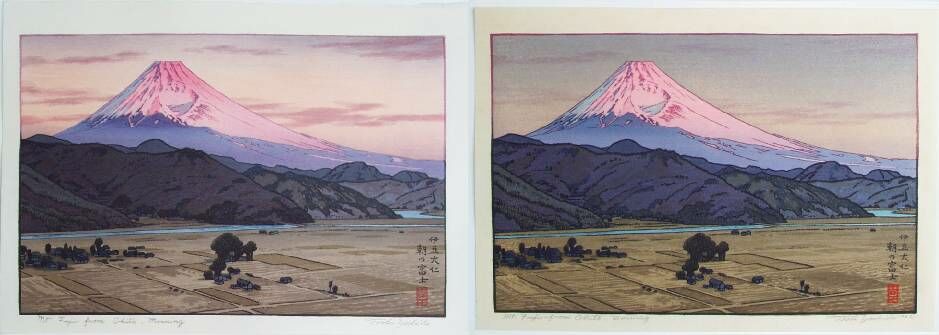
Toshi Yoshida's 1962 Print, "Mt. Fuji from Ohito, Morning" (Newer print left, older print right)
Other than a slightly different "color palette" used by the two different printers, who probably did their individual works some 40 years
apart, there is really very little discernable difference in the overall printing quality of these two prints. Both prints exhibit
skillful use of "bokashi" shading to achieve the delightful gradation of colors seen in the sky, to Mt Fuji, and in the foreground.
In both cases, each print is seen to be crisply printed, with careful attention to details.
Really then, at least in the case of these two "Fuji" prints, the collector who will ultimately choose the "pencil-signed" copy over the later
"block-signed" copy is simply making the decision to pay a modest "price premium" to hold an artist-signed copy in his/her
collection. (In the case of prints by Toshi Yoshida, the supply/demand of the marketplace seems to place an approximate 2X premium
to obtain these "lifetime/pencil-signed" prints.) OK, next let's take a closer look at both of these print's "signatures" as
seen just below.
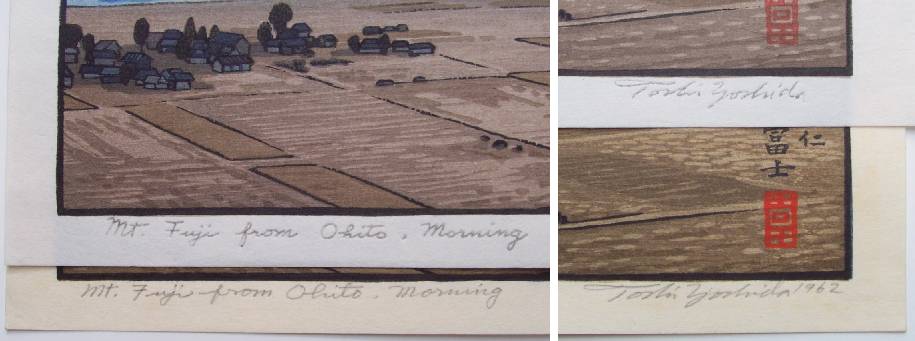
Top: Late 1990's "Block-titled" and "Block-signed" (Posthumous) Copy
Bottom: Early 1960's (1962?) "Pencil-titled" AND "Pencil-signed" Copy
As can be immediately seen in the above two over-laid prints, the actual "pencil-signed" and carved/stamped "block-signed"
signatures of Toshi Yoshida look remarkably similar. In fact, these hand-carved and then ink-stamped "signatures" are usually
so "life-like" in appearance that they can often fool unsuspecting collectors into incorrectly believing that they've purchased
a true "life-time" print.
Here, to help collectors to "tell the difference," we will offer a couple of useful suggestions to keep in mind when examining
the "signature" seen on a Toshi Yoshida print. First, holding the print's "signature" up against an angled light source, look carefully
for the "shiny" appearance of a graphite pencil's lead. If the signature is observed to be "shiny," most certainly then it IS
indeed a "pencil-signed" copy. A second thing to also check for in the same manner (again while holding print in an angled light source)
is the presence of "embossing" or "pressing" into the paper's surface. Here, simply look for "edges and shadows"--if found, these
are a strong indication that the "signature" is, in fact, "impressed" or "block-stamped" INTO the paper's surface by an inked, carved
wooden signature block. If the collector takes the time to check a given print for both of these indicators, there is very little
chance that he/she will be fooled. However, even with sharp eyesight, it can at times be difficult to immediately be sure. Here, a
magnifying glass will prove to be a good friend.
#2 -- February 29, 2004 -- "Watanabe Publisher -- Removal of Margin-Dating"
Recently a threesome of "same-image" prints came our way--of course, giving us the opportunity for a direct side-by-side comparison of
these three prints. The image of which we speak is the beautifully shaded "interior view" of Eisho Narazaki's 1932 print, "Interior of
Asakusa Temple," seen just below.
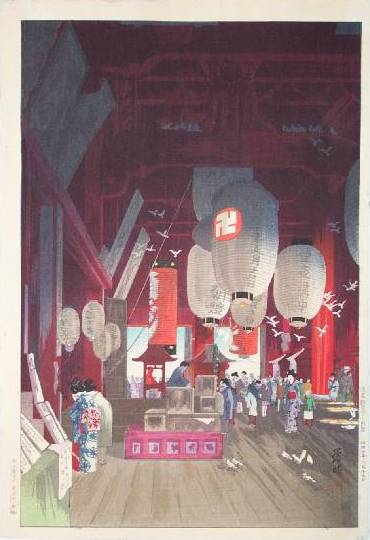
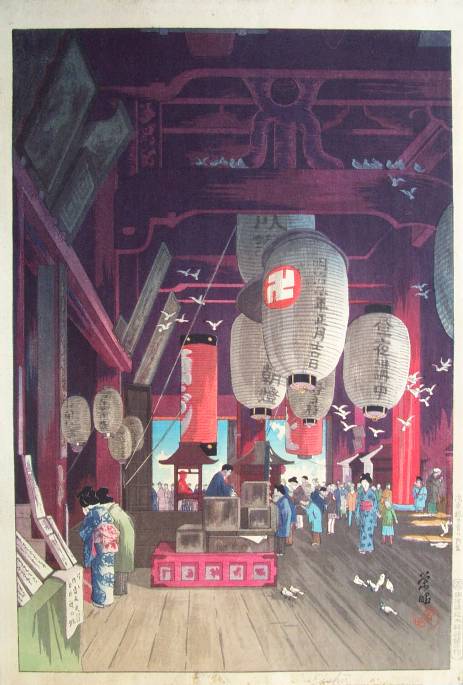
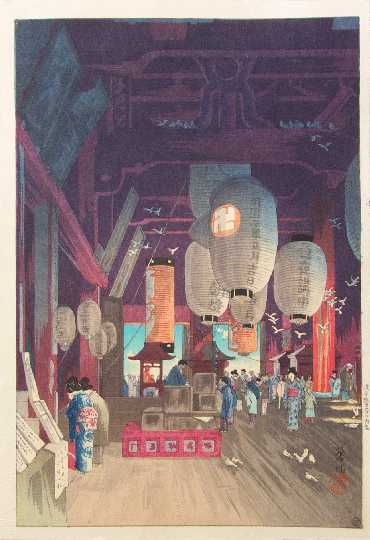
NARAZAKI's 1932 print, "Interior of Asakusa Temple" -- "C-seal," "D-seal," and "6mm-seal"
The interesting thing which was immediately noted was the different location choose for "seal placement" in the print's two earliest
states, and then, the realization that the print's "margin-dating" which is carved into the print's "key-block" had been carved OFF
prior to the printing of the two later examples.
While we were well familiar with this practice of carving OFF a print's "margin-dating" once a print's "first
edition" printing had been completed with respect to prints published by Unsodo Publisher, we did not immediately recall seeing this practice
having been done by Watanabe Publisher. To learn more about this removal of "margin-dates" by Unsodo, please see our discussion
given in our "Quick Reference" article titled "The Seals of Unsodo Han."
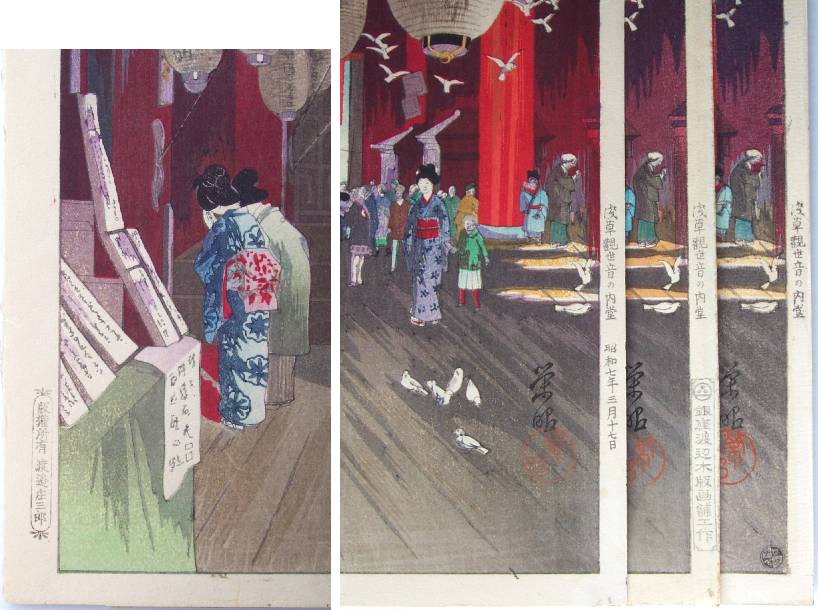
Side-by-side comparion of "C-sealed," "D-sealed," and "6mm-sealed" Prints
As can be readily seen in all three states ("C-sealed," "D-sealed," and "6mm-sealed") of the "Interior of Asakusa Temple" print
above, Watanabe has maintained the print's "title" in all three of the print's (upper) right margins. However, only the EARLIEST
state--a "First Edition" "C-sealed" print (leftmost print)--is seen to have the "margin-dating" lower right which reads
"1932, March 17."
The reader will also notice that the middle print's "D-seal" is applied to the print's lower RIGHT margin--possible to do since
there is now "space" here to do so after the removal of the "key-block's" margin-dating. This is why in the earliest print, the
"C-seal" is instead seen in the lower LEFT margin.....there simply was "no room" for it at the right side.
Seemingly then, at least then in the case of this Watanabe-published print by Narazaki, Watanabe has mirrored the Unsodo Publisher's
practice of "date removal" once a print's first edition printing is completed. Further observations will be needed to determine
how widespread this practice may have been within Watanabe.
#3 -- April 30, 2004 -- "Q & A" of Printing Techniques with Paul
Binnie
Many of our readers are likely already familiar with the prints of
woodblock print artist Paul Binnie, who lives and works from
his home in London. We have featured the remarkable and diverse
artistic
talents of Binnie in several of our prior articles,
including our November 2002 article, "The Making of a Print --
Paul
Binnie's 'Red Fuji'" which gave many insights into the intricate
process of developing a new print.
Here, as an artist, what really makes Binnie remarkable is that HE
ALONE
does it all. That is, he is not simply an artist--he also
does the arduous task of carving all of his own blocks, plus then the
time-consuming task of the sheet by sheet printing. Very few
artists who produce such detailed "shin-hanga" prints such as Paul's
(many
require 20-plus individual blocks) will ever attempt to
also master the skills required to then also be the "carver" AND
finally
then the "printer." This is what makes Binnie profoundly
unique as a woodblock print artist.

UK Woodblock Printmaker Paul Binnie
With the above serving as an introduction, let us next turn a recent
email
exchange with Paul into the following "Q & A" regarding
some specific answers by Paul as to how the actual printing process is
done. We think our readers will find Paul's insights to
be of interest.
U-G Q: "Paul, while we're talking printing, I've got a couple
of
"how's it done" questions for you. First, when a
printer is doing a large batch of, say, perhaps 100 impressions, does
he
print ALL 100 sheets by the "first block" (that is,
"first" color) BEFORE moving on to printing the "second block"?? In
other
words, are all 100 sheets printed on the SAME DAY
and then "hung up to dry," before moving on to the "next/second block"
which is done the FOLLOWING day?? And hence, if
20 blocks, it would then take "20 days" to complete printing?
OR.....are
only 8 or 10 (or so) prints done on a daily
basis--with "ALL blocks/ALL colors" printed the SAME DAY, while the
paper
is still somewhat moist?"
Binnie A: "All sheets to be printed are printed with one colour
at
a time, then the next colour is applied and so on.
I find that I can print simple colours -- that is, with no "bokashi"
(shading) -- about 80-100 (sheets) in a day. But if with
"bokashi," it takes two days or more to print just one (smaller) area."
U-G Q: "When doing "bokashi" shading -- such as a "dark shadow"
cast upon a sidewalk (SEE "shadows" in Koitsu's
"Tea House"
print -- is the "bokashi" ALWAYS done onto a "wider,
flat-area" of the UN-carved woodblock's surface..... OR is it possible
to
"carve out" the actual SHAPE of the "shadow area"
itself??? Here, I've had one individual insist to me that the
"sidewalk
shadow" of "Teahouse" was CARVED into a separate
block..... however, seems to ME that it's simply achieved by using
"dark
ink".....as a separate impression.....upon the
SAME WIDE FLAT "pinkish block" which is used for the entire
"street/sidewalk area." Hence--I'm further assuming that
"print-to-print," the "bokashi shadow" could VARY AS TO POSITION,
simply by
"how" the printer applied his inks upon the
WIDE block face.
Binnie A: "Both methods are possible; if you want a very
precise
area of colour, it's best to carve a block to apply
it, but if you want a soft shaded bokashi of no particular shape, it's
hand
applied from a larger carved area."
U-G Q: "OK then Paul..... your earlier comment of: "doesn't
just
happen in one impression: even a simple bokashi
can take up to six different intensities of ink to achieve the smooth
shading neccessary" ......raised this question to me.
Did you mean "six PRINTINGS" done to achieve a single "bokashi"
effect??"
Binnie A: "Yes."
U-G Q: "Or, did you instead mean "six ink applications" onto
the
SAME block's surface.....prior to applying ONCE to
paper's surface??"
Binnie A: "Not usually, as the block would need to be wiped
down
each time and re-inked
each time, increasing the time needed to print. Hope this helps."
The following day, we then presented a final follow-up question to
Paul.
U-G Q: "Thanks for your reply to the "printing questions" --
very
much appreciated. If I may, one final related
question. Kindly take a look at these TWO "different shadow" versions
of
Koitsu's "Tea House" print:
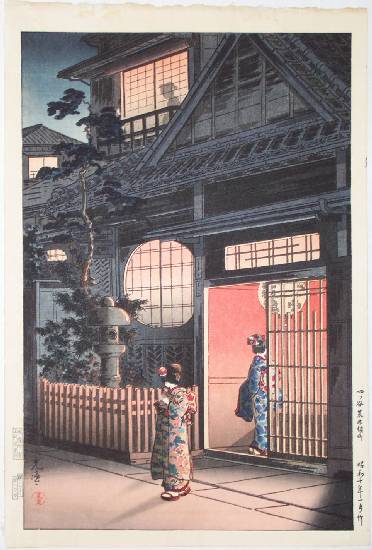
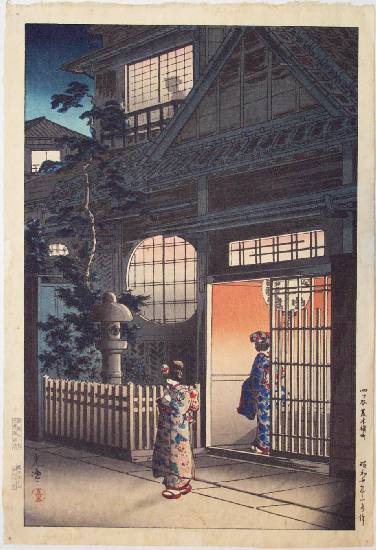
Koitsu's "Tea House" (#CG-638)
--
Koitsu's "Tea House" (#CG-639)
U-G Q: "Here, note the slightly "different slope" (or angle) of the cast
shadows.
And also, different shading seen towards left in
both prints. Do you think that these "shadows" are CARVED..... or is
variation achieved by simply different "bokashi
application" to a WIDE AREA of blank (smooth, uncarved) woodblock??
What's
the most likely method??"
Binnie A: "These two areas of cast shadow are printed from a
flat
wide area, not a specifically carved block, and
the yellow-beige ground block is where they have been printed from, to
give
a soft-edged feel of natural shadow. That is
why they differ in each impression: if there was a block carved for the
shadow, it would be the same in ach and every
impression, whereas what Koitsu wanted was to have a softer look to the
shadows. Note also that the edge shadows on that
block have been printed with bokashi and not from a carved block, too."
U-G Q: "As always Paul, thank you very much for the expertise
and
insights that you've shared with us and our readers."
Binnie A: "Glad to do so. It's always a pleasure to speak with
you."
Hopefully then, this short exchange of questions with Paul will give
collectors of Japanese prints a much more in depth
appreciation of the consummate efforts that are required to produce each
and
every copy of a hand-printed woodblock print. The
above exchange should also help to reinforce the fact that prints are
NOT
alone solely the product of an "artist" -- instead,
much of what we enjoy and treasure as collectors is clearly also the
result
of the often under appreciated or unrecognized
efforts of the carver and printer artisans.
#4 -- June 27, 2004 -- "Attached 'Jan-Dec 1936 Calendar' Yields Dating of RARE Hasui Print"
Recently a fellow member of the woodblock print-collecting community brought to our attention what is now our "5th sighting" of
the fairly RARE and largely unknown Hasui print, "Shinto Shrine of Kasuga at Nara," published by Shimbi Shoin
Publisher of Tokyo (active 1905-1936) which is a summertime version of
a much more common wintertime red temple print titled "Kasuga Shrine at Nara" ("Nara Kasuga Jinsha") published by
Watanabe Publisher.
What makes this sighting especially valuable is the fact that this copy of "Kasuga" has ATTACHED to its face a tiny
"Jan-Dec 1936 Calendar" (shown below). Therefore, we now conclude that the date of origination for this Shimbi Shoin-published
print is most certainly 1935. To learn more about this fascinating print, see our website's June 2003 article
titled "The Unknown 'Kasuga Shrine' Print of Hasui KAWASE."
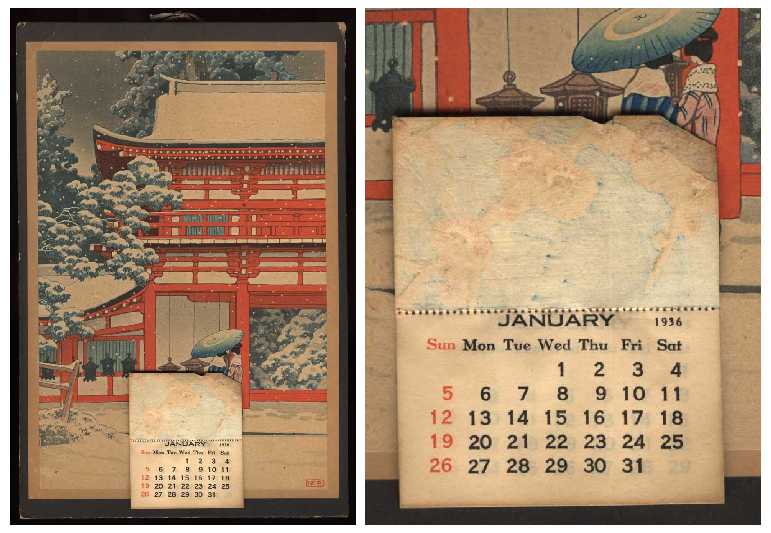
Newly Found "Shinto Shrine of Kasuga at Nara" Print (1935), bearing attached "Jan-Dec 1936 Calendar"
We also wish to point out that it is this free exchange and sharing of information within the Japanese woodblock
print collecting community that continues to add to the documented body of knowledge about these prints. (And so,
a warm "thank you" to Peter Belsito for sharing this information with all of us fellow collectors.)
#5 -- July 02, 2004 -- "Two 'Monkeys Reaching for the Moon' -- More 'Look-Alike' Prints"
A with many of our readers, we at Ukiyoe-Gallery.com have many "images" etched indelibly into our minds. Indeed, as Arthur Ficke wrote
nearly a century ago “Once one knows (an) image (it) is ineradicably stamped upon the memory......I can never lose them, they
are a part of my vision."
Recently then, we were immediately struck by a feeling of "deja-vu" when we encountered a "shikishiban" (squarish)
format Gekko OGATA (1859-1920) print of a little tree monkey reaching downwards towards the "oval shape
of a full moon" seen reflected in the surface of the pond's water below him. Seemingly curious about what he was
seeing in the water below him, he is delightfully seen trying to reaching out and touch it.
Having previously encountered a very similar Koson-designed version of this seemingly "look-alike" image, we
immediately recognized the similarity..... and so, we set out both prints together for a side-by-side comparison and
photo shoot. Both prints are seen just below.
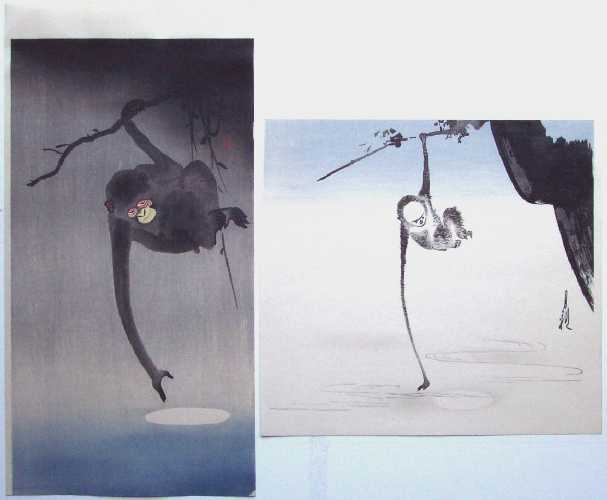
Koson's "Monkey Reaching for the Moon" (ca1910-23)
-- Gekko's "Monkey Reaching for the Moon" (ca1895-10)
With both print's monkeys facing the same direction, and both hanging from their left arms onto a left-facing limb while
reaching downward with their outstretched right arms, there seems to be little doubt that these two prints shared a
common design. In other words, the degree of their similarity seems too closely identical to be merely coincidence.
That said, it is our conclusion that the tall/narrow ("tanzaku") format pre-earthquake (the 1923 "Great Kanto Earthquake" which destroyed much of
Tokyo) design by Koson is most certainly copied from the likely earlier squarish ("shikishiban") format done by the
largely late-Meiji artist, Gekko. Although both prints are undated, we estimate the Koson design to be of the 1910 to
1923 period, while the Gekko design most likely dates to the late-Meiji 1895 to 1910 period.
Just below, we give our readers a second detailed close-up view of these two prints.
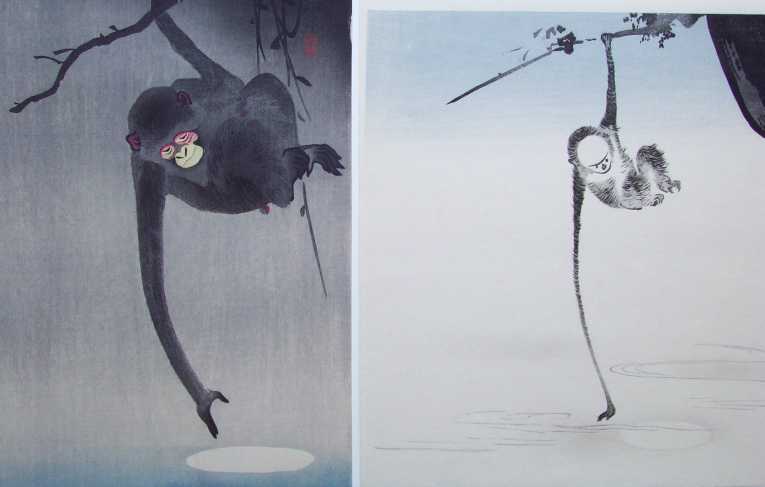
Close-up Detail of both "Monkey Reaching for the Moon" Prints
Without a doubt, clearly the technical excellence of the later Koson print exceeds that of the early/simpler design
by Gekko. In this respect, the printing quality of Koson's "Monkey/Moon" print is more typical of these later "shin-hanga" era
prints--that is, more attention to small carved details, more skillfully executed "bokashi" shading, greater use of
colors, etc.
As with several other of our UNdated examples of "look-alike" prints, of course much of our opinion is based simply on
conjecture and opinion on our part. In other words, no proof--simply common sense based on our observations, knowledge
and experience. That said, as in all cases, we'll again let each observer reach their own conclusions.
#6 -- August 18, 2004 -- "Edition Size for 60th Anniversary 'Commemorative Edition' Goyo Prints"
Recently, one of our readers of Ukiyoe-Gallery.com sent to us an email and image which now gives us further definitive
information about the "edition size" of the 60th Anniversary "Commemorative Edition" Goyo prints which were
sanctioned by Goyo's family during the very early 1980's. This "lable" is seen just below.
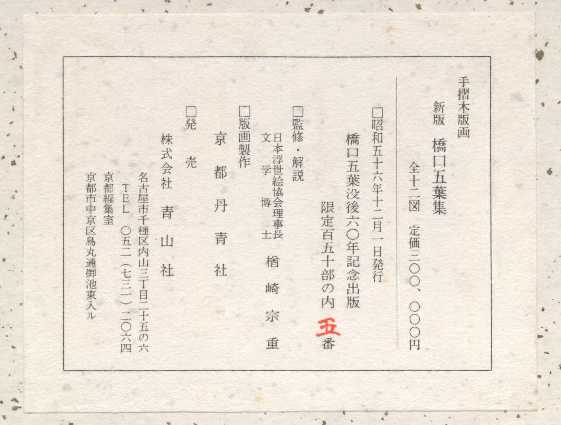
Lable attached to "Commemorative Edition" Goyo Print Set (published by Tanseisha Publisher)
Reading this Japanese lable, what we have now been able to learn is that prints of this 60th Anniversary "Commemorative Edition" set
were indeed published in December of 1981 ("Showa 56"), and that these Goyo prints were produced as a limited "edition size"
of only 150 impressions each. In this case, the "red hand-written character" seen above indicates that this was
"set #5" of 150 total "12-print sets" published by Tanseisha Publisher.
It is also interesting to learn (see lable's right edge) at that time--some 23 years ago--this "12-print Goyo set"
then sold for a total of 300,000 yen, or an average of 25,000 yen per print. (At the approximate dollar/yen exchange rate of that
time, that would have been about $1,875 for the set, or about $156 per print. At today's current exchange rate, this
would be approximately $2,730 for the set, and about $227 per print.)
Of course, over the past two-plus decades, these and nearly all other Japanese prints have increased in value as the
universe of Japanese print collectors has grown worldwide. And to collectors of prints of the "shin-hanga" era,
because of their extraordinary beauty, the "bijin-ga" prints by Goyo are among the most highly prized of all. With
various embellishments such as their sumptuous "mica" backgrounds, gold metallic pigment highlights, extensive
use of "gauffrage" (embossing), and skillfully executed "bokashi" shading, is it any wonder that these prints are
so highly valued?? Shown below are three of Goyo's beauties.
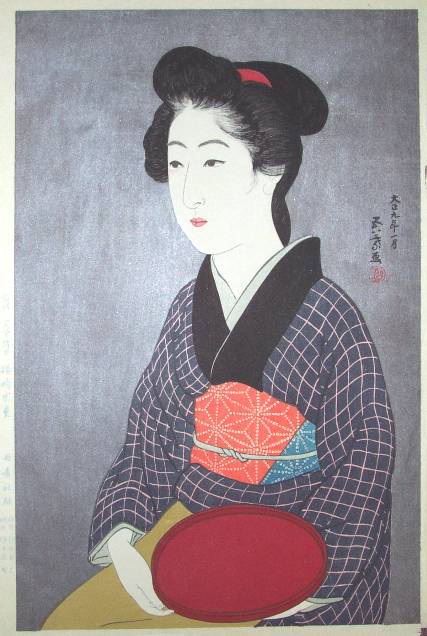
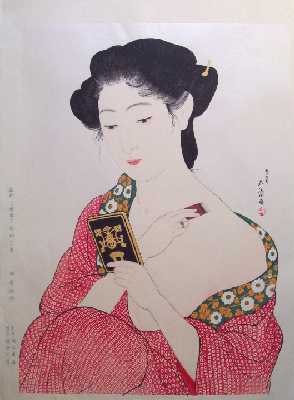
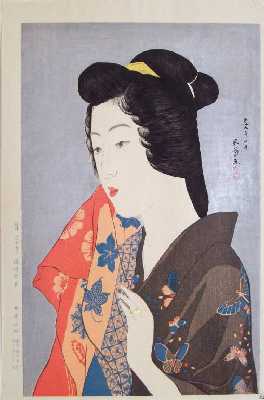
Goyo's "The Waitress O'nao"
--
Goyo's "Woman Applying Make-up"
--
Goyo's "Woman Holding a Towel"
Without a doubt, the technical excellence of these Goyo prints is why these prints remain so highly sought-after
by Japanese print collectors.
#7 -- August 20, 2004 -- "Shoichiro Watanabe Explains "Azuma Gorge" - One Print with Two Dates of Origin"
Recently, a reader of Ukiyoe-Gallery.com sent to us an email exchange between himself and Shoichiro Watanabe (the present
day owner of the S. Watanabe Color Print Company, and grandson of founder Shozaburo Watanabe) which seems to
offer a somewhat reasonable explanation as to why a single Hasui print image, "Azuma Gorge," exists with two
DIFFERENTLY "margin-dated" states (both 1943 and 1947) as mentioned in our May 2003 article,
"Hasui's "Azuma Gorge" - One Print - Two Dates of Origin?"
This 1943 and 1947-dated "Azuma Gorge" print is shown just below.
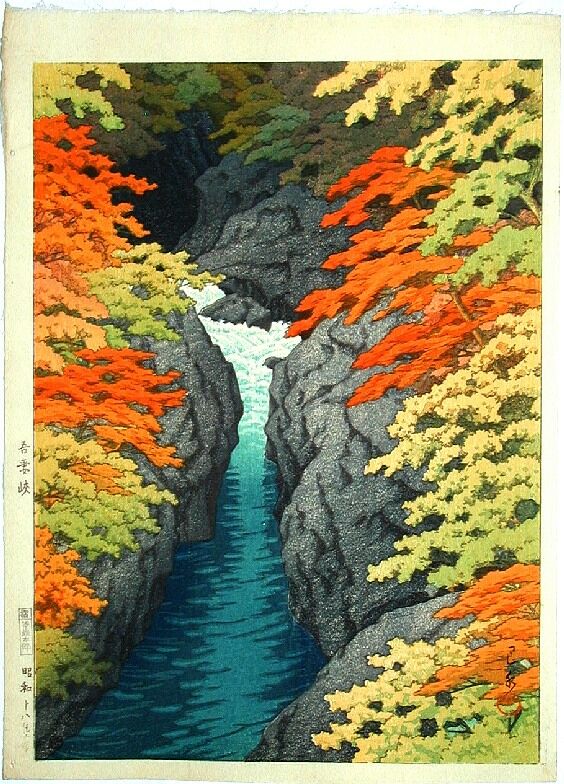
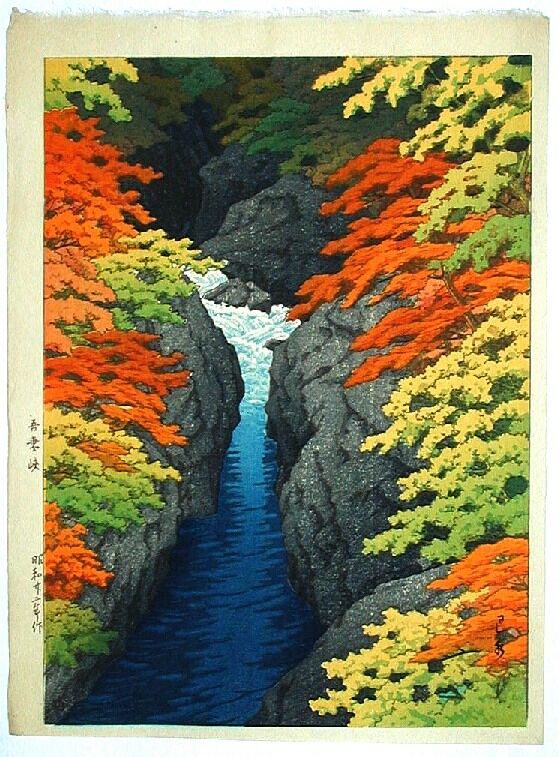
Hasui's Watanabe-published "Azuma Gorge" Print -- (1943-dated version left, 1947-dated version right)
As he was himself curious about how and why this "double-dating" could happen, this reader simply and directly asked
this question of Shoichiro Watanabe. (Gosh...... we're wondering now...... Why didn't we think to do that??)
Here is the pertinent portion of his email to Shoichiro:
".....I also wondered about the date, as "Agatsuma (Azuma) Gorge" is listed as being carved in 1943, but is the
date on the print margin 1947?"
Here then is Shoichiro's somewhat longer, explanatory reply:
"Azuma Gorge is located in Saitama Prefecture and is very small.
Agatsuma Gorge is located in Gunma Prefecture(north of Saitama Pref.) and is very big.
Hasui had traveled to Agatsuma but not to Azuma. (The note of the "Complete (Hasui) Catalogue" by Hotei Publishing
is wrong.)"
"In 1943, S. WATANABE CO. finished the test printings (only a few copies) for this design. As you know, in 1943, toward
the end of the World War II, S. WATANABE CO. lacked for the paper and all the materials for printings. In addition,
printers had to go to War. So we could not do it at all."
"We could made printings of this on 1947 at last, 2 years after WWII. So there are two types of the date (1943 and
1947). Therefore, the prints dated 1943 is quite few."
"Although our new "atozuri" (posthumous printing from original blocks) print is dated "Showa 22 nen" (1947), we do
say this is dated 1943 the same as in the "Complete (Hasui) Catalogue" by Hotei."
"If any question, please ask me again. I will do my best to answer you."
Sincerely,
Shoichiro Watanabe
S.WATANABE COLOR PRINT CO.
To clarify further then, in the words of our contributor, "I would add an explanation of Shoichiro's comment about
the difference in the name of the print in the Hotei catalogue and the actual name of the print in the Watanabe
inventory. Hasui never visited Azuma Gorge, and the print is actually of Agatsuma Gorge. As Shoichiro notes,
Hotei got the name wrong. So what we have is a print with two different dates AND two different names!"
Thanks then to our thoughtful reader, at least in this case, it seems the mystery as to the true dating of this
"Azuma Gorge" print has now been answered.
And--as always--we are appreciative to our audience for both their readership and their input.
#8 -- Coming Soon.....
|


















